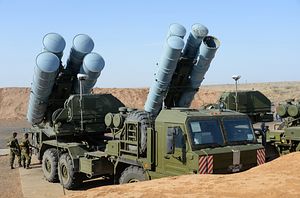The second batch of Russian-made S-400 Triumf long-range interceptor-based air defense systems (NATO reporting name: SA-21 Growler) destined for service in the People’s Liberation Army’s Rocket Force (PLARF) is slated to begin in late July, a Russian government source said on April 3.
“The transport vehicle with the first batch of equipment from the second S-400 regimental set for China will put to sea in the Baltic in late July this year, that is almost five months earlier than the term set in the contract,” the source was quoted as saying by TASS news agency this week. The total transport will consist of three vessels. Notably, the source did not specify when the second and third ships will deliver their cargo.
The Russian Ministry of Defense (MoD) has neither confirmed nor officially commented on the supposed delivery date. China received its first S-400 regimental set in 2018. Delivery of the second regimental set was initially expected to be completed by the end of last year. However, Russia claims that a ship carrying an export variant of the S-400’s most advanced interceptor, the 40N6E, reportedly capable of intercepting targets at a distance of up to 400 kilometers, was damaged in a storm in the English Channel in early 2018, delaying the completion of the order by a couple of months.
The PLARF expects to stand up two S-400 regiments with total acquisition costs estimated at around $3 billion. As I noted before:
The standard S-400 battery consists of four transporter erector launchers (TELs) with four large launch tubes or 16 smaller tubes (or a combination of the two) per TEL, in addition to long-range surveillance radar target acquisition and engagement (fire control) radar systems and a command post (vehicle). In the Russian military, two batteries make up an S-400 battalion (also known as an S-400 division), whereas an S-400 regiment consists of two battalions.
Each TEL can carry four long-range or up to 16 short- and medium-range missiles. An S-400 regiment also possesses additional surveillance and target acquisition radars, with the unit generally plugged in to larger long-range radar stations or airborne early warning systems. It is, however, unclear whether Russia has developed such a so-called Cooperative Engagement Capability (CEC).
Furthermore, I explained:
In comparison to its predecessor, the S-300, the S-400 air defense system features an improved radar system and updated software; it can purportedly fire four new types of surface-to-air (SAM) missiles in addition to the S-300’s 48N6E, a vertical tube launched, solid fuel, single stage SAM with an estimated range of 150 kilometers (93 miles), and the improved 48N6E2 missile with a reported range of 195 kilometers (121 miles).
(…)
The S-400 is also armed with an improved variant of the 48N6E2 with an alleged range of 250 kilometers (160 miles). The air defense system can also fire two additional missiles, the 9M96E and 9M96E2 with respective ranges of 40 km (25 miles) and 120 km (75 miles). Improved S-300 air defense systems such as the S-300PMU-2 Favorite … can purportedly also fire the 9M96E and 9M96E2.
The Russian military has been training PLARF personnel on the S-400 air defense system over the last months. The PLARF has also conducted a number of live fire tests as part of the weapons systems’ user trials in November and December 2018.































